Congratulations!
Your new OneSails Headsail has been designed specifically for your boat using some of the best software and talented sail designers in the world. It has been crafted from the finest materials and built with the precision of the passionate sail makers at OneSails. Your local OneSails representative will be happy to assist you with setting up your new sail.
Before we get started there are a few important things to consider:
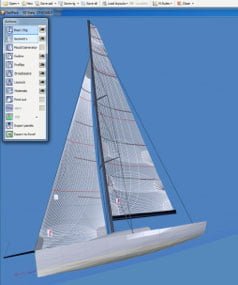
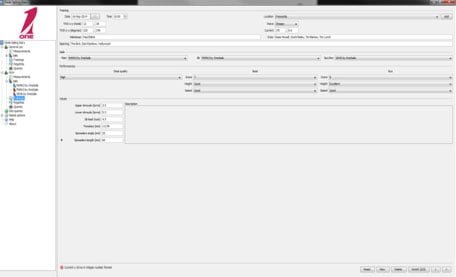
Your designer will have designed your sail with particular maximum depth (draft) position and entry angle which is optimized for your boat, the wind range of the sail, the material used in your sail and the amount of forestay you will encounter (with varying backstay tension).
As a general rule the more wind you have the more luff tension you should apply, particularly when sailing hard on the wind. This is largely due to the sails maximum draft moving back as the sail loads up. Factors that contribute are stretch, forestay tension (via backstay or forestay tightened) and to some degree the jib car or sheet position and tension.
In light conditions a few wrinkles on the luff of your sail is ok, but too much tension could see the sail have a distinctive ’knuckle’ in the front. As soon as the wind increases and the sail loads up remove the wrinkle and continue to add luff tension as the sail moves up it’s designed wind range.
To care for your sail un-load the sheet before adding luff tension. Avoid over tensioning the luff before checking with sheet tension as this will add to the life of your sail. It is a good idea to mark your halyard with luff tension marks, this way you can easily repeat fast settings and accelerate set up times when racing.


Adding luff tension moves the draft forward gives the sail a rounder entry compare the draft stripes above to see the difference in sail shapes between less tension (top) and more (below)
The jib lead position on most boats adjusts the leech tension and foot tension on the sail by moving fore and aft. For the leech the twist of the sail will be adjusted and for the foot it will affect the depth in the sail. Different conditions will see you treat the lead position differently. If in doubt first set your jib lead up so that if you extended the line of the sheeting angle it would intersect the middle of the luff.
As a general rule at the lower end of your sails range you will have the lead further forward to keep the bottom of the sail more powerful and the leech with old enough twist to keep the sail ‘breathing’. As the wind increases and the boat no longer needs all the power the lead is gradually moved aft to flatten the foot and increase the twist. This achieves two primary functions, firstly with the sail becoming flatter there is less drag so therefore the aerodynamic profile of the sail becomes more efficient and the boat goes faster. Secondly the added twist allows the accelerated air to exit quicker which, increases lift and reduces drag which creates less disturbance on the mainsail.

Lead forward for powerful foot and twist in light winds. Note the twist in the leech (red) and the slot between the jib and the mainsail is clear.
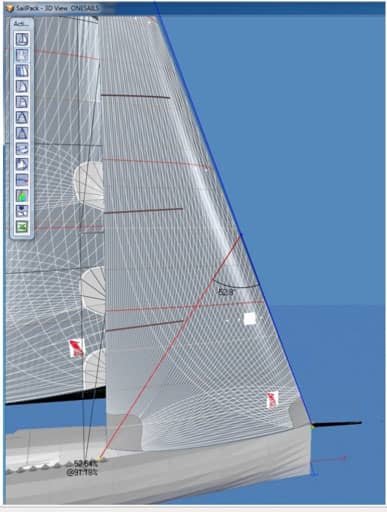
As a starting point, set your jib lead up so the jib sheet intersects the luff about half way.
Being the primary control on any sail the sheet is the most important and most frequently adjusted. The amount of wind, the sea state and how the boat is behaving will determine how mush sheet tension is applied. The goal is to have the jib sheeted as close as possible for maximum upwind performance without being on too hard where the sail stalls and the boat slows dramatically.
As a general rule as the wind increases, the more sheet tension is applied. Too much when the wind is light and it will definitely stall. Too little and the boat won’t ‘point’ (sail close to the wind). Remember that the fins below you (keel and rudder) also need flow for the boat to work too! When trimming the jib – go for boat speed first so your foils get a grip on the water then trim the sheet on gradually to get the height. It is very important to do this in and out of manoeuvres, for example tacking and starting and also through changes in wind speed and in gusty conditions.
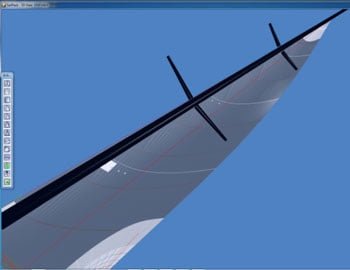
Overlapping jib with the sheet tension so the sail sits 0 – 5cm from the spreader tip(s) for medium air.
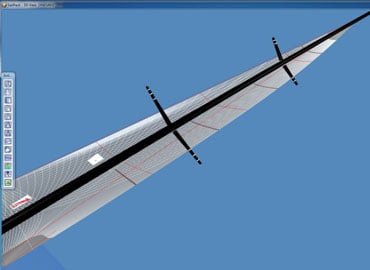
Non overlapping jib sheeted at 8 degrees – note the spreader reference marks to indicate sheet tension.
Used on boats with non-overlapping jibs, the inhauler changes the position of the clew on the jib relative to the centreline of the boat. This effectively alters the sheeting angle of the jib in the quest to make the boat point higher to the wind. The inhauler can come in two forms – either a transverse tracks (in/out tracks) or by a floating barberhaul line on a purchase system which physically pulls the jib sheet inboard between the clew of the jib and the fore/aft jib car. Inhaulers are only ever used when sailing upwind.
As a general rule in light winds you have the inhauler set almost all the way in allowing you to use soft sheet tension and make the bottom of the sail deep and powerful, while nice and twisted in the top without stalling it. As the breeze increases and more sheet tension is applied the sail continues to flatten out as it is pulled on and set closer to the rig increasing pointing ability. Only start easing the inhauler when you are at the top of the sail range and you need to de-power. Make sure all other controls have been used at this time – maximum forestay tension (backstay), maximum halyard, Jib Lead (car) aft and the sail is as flat as you can make it.
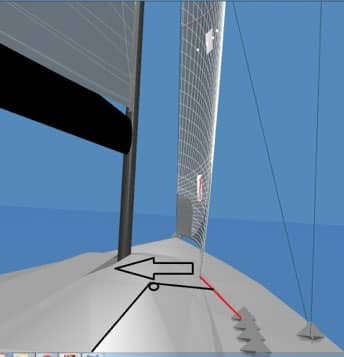
Inhauler in light and medium conditions increases pointing ability – be careful not to close the slot and stall the sail. Talk to the mainsail trimmer to see if the mainsail is back winding too much.

In heavy air you will need to let the inhauler off, especially if the mainsail traveller is eased to leeward, as this starts to close the slot between the two sails.
As the sail loads with more wind the forestay will start to sag to leeward with this load affecting the depth (fullness) of the sail. As we know a fuller sail is more powerful so this can work as much for your boat speed as it can against you. In lighter winds with forestay sag you can create a very powerful jib but as soon as the breeze increases the sail needs to be flattened not only with the jib lead position but also by tightening the forestay. This is done on most boats by tightening the backstay which in turn tightens the forestay. On boats with running backstays this does the same thing. Some modern race boats also have an adjustable forestay via hydraulic systems, whereas the same can be achieved on most yachts for sailing in specific conditions by adjusting the forestay before racing for set conditions.
As a general rule start with little or no backstay in light conditions to have the sail full and powerful. As the wind increases keep tightening the backstay to flatten the jib. The tension will also help your mainsail shape too. Forestay sag is considered the enemy once the boat is powered up, as it effects how close the boat can point to the wind and adds unwanted depth therefore dragging the boat’s aerodynamic profile and slowing it down.
Eldrid super tip – your backstay should be calibrated and if you are using a simple purchase system you can still use a tension gauge to record the load of your backstay for each of your marks. If your backstay is hydraulic – get to know how many PSI each of your marks is. If you have a load cell be sure to record your kg settings in your OneSails Tuning Diary!

Forestay sag (seen here against the blue line) can help you with power in light winds. Increasing the forestay tension by pulling on backstay will flatten the jib. You can also tighten the forestay for stronger wind, reducing the sag.
Telltales are a reference as to how the wind is flowing across your sail. They should be used as a reference to your sails trim but not over analysed as the pursuit of perfect, even flow may see the sail trimmed without consideration for the power, heel angle, sea state and ease of steering for the driver.
As a general rule in light winds the goal is to have all telltales flying horizontal which indicates you have flow across the sail. Approaching medium winds the telltales on the leeward side should be streaming straight, and the windward side straight to slightly lifting up to 45 degrees which is achieved by the driver keeping the boat up in the steering ‘groove’. In strong winds the sail may need to be feathered by sailing high in the steering groove and the windward telltales will be lifting vertically.

Telltales in light air
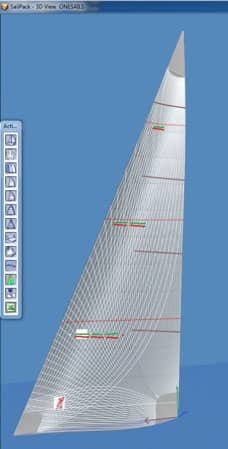
Telltales in medium air
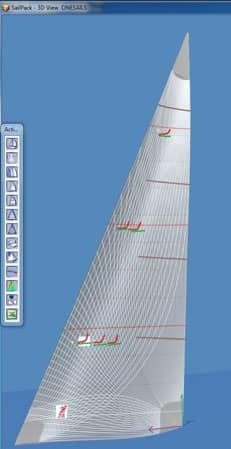
Telltales in heavy air
“Sail fast and have fun!”
OneSails Team
Signup our newsletter to get updates, information, news, insight or promotions: